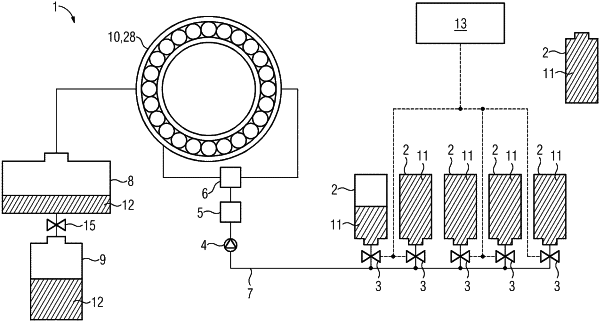| CPC F03D 80/70 (2016.05) [F16N 7/38 (2013.01); F16N 19/00 (2013.01); F16N 31/00 (2013.01); F05D 2260/98 (2013.01); F16N 2210/025 (2013.01); F16N 2210/14 (2013.01); F16N 2270/22 (2013.01); F16N 2280/00 (2013.01)] | 2 Claims |

|
1. A method of lubricating a wind turbine by a lubrication system, the lubrication system comprising a lubricant consumer to which fresh lubricant is supplied and out of which used lubricant is extracted, a pump for pumping fresh lubricant to the lubricant consumer, a waste lubricant collector where used lubricant can flow after being extracted from the lubricant consumer, a plurality of containers delivering fresh lubricant to the lubrication system, input valves for controlling the flow from the containers and a control unit for controlling the flow through the input valves, the method comprising:
connecting a first container of the plurality of containers being filled with fresh lubricant to the lubricant consumer and having a second container of the plurality of containers being filled with fresh lubricant disconnected from the lubricant consumer;
extracting fresh lubricant from the first container by the pump;
monitoring if the first container is empty and/or monitoring the filling level of the first container; and
connecting the second container to the lubricant consumer when the first container is empty or when the filling level of the first container is lower than a predefined value,
wherein the method further includes monitoring how long the fresh lubricant is stored in the different containers by keeping track of the time when the containers were refilled or replaced and connecting the containers to the lubricant consumer according to the time when the containers were refilled or replaced in such a way that containers containing fresh lubricant stored for a longer time are connected first.
|